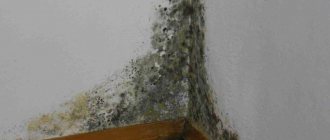Cracks and leaks as causes of sewer smell in a private home
So, you have discovered a specific smell in your home. To find out why there is a sewer smell in a private home, start by inspecting the system itself. Carefully examine the condition of the pipes, the plumbing fixtures themselves, as well as the joints and connections. If somewhere there is even a small leak of water, it means that this is where you need to look for chips, cracks or loosely connected elements. Remember, even a small crack can cause a foul smell throughout the house. After this, you will be haunted by thoughts of how to get rid of the sewer smell in the bathroom.
During inspection, pay special attention to studying the siphon. It happens that its lid is not screwed tightly enough. Therefore, the smell can also penetrate outside from here.
To ensure the tightness of the sewer system and seal any identified cracks, arm yourself with special sealant mixtures. Sometimes you just need to replace the gaskets. Read also: “How to fix a sewer leak - how to seal a pipe.”
How to understand that the problem is in the exhaust system
An exhaust system is installed in all rooms where sewerage with water supply is carried out. Find ventilation ducts in the bathroom, toilet or kitchen. They are located under the ceiling and covered with bars. The easiest way to identify problems is in the ventilation system. You can do this yourself.
Check traction
- Bring a piece of paper to the channel. It must be held in place by traction. If the leaf falls, it means the ventilation is not working well.
- Another way to check if the stench is coming from the ventilation duct is to seal it for a few days. If there is no smell during this time, then you have presumably found the cause.
Ask the neighbors
Often the smell in the apartment begins to be felt after the sewer system has been repaired by the neighbors. Since all pipes in apartment buildings are connected to a common riser, odors can come from neighbors. In this case, their supply line or water seal may be broken, and the smell rises or falls towards you and penetrates through the ventilation shafts into your apartment.
Inspect the reservoir
The common collector, which is located on the technical floor or in the basement, may also become airy or clogged. This can also give an odor into the apartment through the ventilation shaft.
Check the plugs on the pipes
Sometimes the reason why an unpleasant odor appears can be quite simple - the plug falls off the pipe.
Check your pipes. If you see an open hole, check to see if the plug has moved? Sometimes even a small crack is enough for the “aroma” to start coming out. This is especially true for those risers where the fan riser is cut off. It is not recommended to suppress it even in two-story and private houses, not to mention high-rise buildings. Why? The website www.sympaty.net will tell you below.
Inspect the fan riser
The fan riser is a round wide pipe (riser) that should go into the ceiling. It is usually located in the corner of the bathroom or toilet, as if cutting into the ceiling. Often residents of the upper floors cut it off and plug the exit. The smell is not removed from the apartment, but collects in the riser. Then it begins to seep even through small cracks. It is not recommended to cut and plug this riser, especially in apartment buildings.
- Firstly, the smell has nowhere to go.
- Secondly, under the influence of the force of air, when neighbors below flush the toilet and pour water into the sink, the plug moves. Because of this, the smell begins to wander around the apartment, not only on the top floor, where someone installed a plug, but also on the lower floors. So, if your toilet smells like sewage, and you don’t know what to do, ask your neighbors on the top floor about the riser - is it led to the roof or is it plugged?
Patency is impaired
You can also check on the roof whether the outlet of the riser has accidentally become clogged with debris or whether something has fallen on top of it, or whether it has frozen over in severe frost? To check the conductivity yourself, hold a sheet of paper to the outlet of the riser. If the sheet is attracted, then the pipe is functioning. If not, you need to clean it.
Siphon is empty
If you still haven’t figured out why the bathroom smells like sewer, it’s worth inspecting the siphon. During daily use, the siphon is always filled with water. But it happens that plumbing equipment is not used for a long time. For example, residents went on vacation. Then the water in the siphon dries completely. And the accumulated odors begin to gradually leak out. This is where the smell from the sewer system arises in a private home. But getting rid of the stench in this case is very simple and easy. It is enough to let the water run through the taps, and, of course, start using the plumbing fixtures. As a result, the smell will disappear in just a few hours.
Ventilation doesn't work
If there is a smell of sewerage in a private house, then a possible reason could be poor ventilation of the entire system in the house. Place a regular piece of paper over the vents. If the leaf falls down, the ventilation does not work. All pipes need to be cleaned. Examine them for blockages and dirt. Clean thoroughly. If the ventilation in the house is extremely poor, then experts even advise installing a forced air purification system. To do this, a small fan is placed in the ventilation hole. It will help clear the air of accumulated sewer odors.
Sewer pipes are clogged or improperly installed
It happens that an unpleasant odor appears only when water is discharged from the tank. There are two possible options here. In the first case, the pipes are simply clogged due to the fact that a large amount of suspended matter and sediment has been deposited on their walls. Therefore, it is urgent to clean the pipes.
This is usually done by specialists. They have a plumbing cable that can easily deal with any type of clogged pipes. Doing this procedure yourself is quite difficult. And in the second case, it is possible that the pipes are installed with too small a diameter. As a result, sewer odors enter the house. Unfortunately, if this turns out to be the reason, you will have to replace the pipes; there is no other way to solve this problem.
Microcracks in the drain of the sewer system
Another possible cause of unpleasant odors is microcracks or diaper rash that form in inaccessible places. They become sources of sewer “odors” and are very difficult to find and eliminate. Way out of this situation:
- replacing a damaged pipe with a new, better one;
- treating all suspicious areas with a sealant.
Connecting plumbing to the sewer
In order to prevent leaks from occurring in the future, and therefore the appearance of foreign odors from drainpipes, it is necessary:
- install high-quality plumbing pipes, only from trusted manufacturers (although they are not very cheap);
- when laying drainpipes, it is recommended to make as few joints as possible; cracks most often occur in these places;
- perform high-quality waterproofing of the floor and walls in the bathroom or toilet;
- place joints only in easily accessible places, although this is not always possible.
Trunk pipes were laid incorrectly
According to the standards, pipes of the main route must be laid at a strictly defined angle or inclination. If this requirement is not met, then the water in the pipes begins to stagnate. Although, if all conditions are met, such “rotting” of water is impossible.
How to eliminate the smell of sewerage in a private house in this case? Unfortunately, you will have to deal with the new installation of pipes, while observing all regulatory requirements, in particular, the placement of pipes with a slope (for more details: “How to eliminate the smell from the sewer using available means”). And first dismantle the old pipes. By the way, if the pipes are located on a common property, then it is logical to ask the management company about their correct placement. Its competence includes resolving such issues. Here, perhaps, is a description of all the possible reasons that can cause sewer odors in your home. Remember, once you find the cause, you can easily get rid of the problem itself!
Sewer smell in a private house: why does it appear and what to do
.
Many owners of private houses are faced with an unexpected problem - an odor from the sewer system appears in their rooms and premises. This problem can arise even in buildings that were built quite recently and have modern, new sewer networks.
Do you have a specific smell in your private home? To effectively eliminate it, it is necessary to identify the cause
There can be many reasons for this situation. Identifying the sources of unpleasant odors will allow you to use an effective method that will make it possible to eliminate the smell of sewerage in a private home. Let's consider this problem in detail.
general information
Before finding out the causes and ways to eliminate sewer smell, you need to look at the features of the waste disposal system in a private home. The standard sewerage system of a private house is divided into two sections:
external; interior.
The external sewage system can be autonomous or centralized. In the second case, the pipes are connected to a unified waste disposal system. With an autonomous system, the liquid is discharged into a septic tank. The septic tank is cleaned of waste as it fills.
Internal sewerage includes:
We recommend: How to find a wire break in the wall: find the location of the wire break using a multimeter
Riser. Fan pipe. Sewer distribution throughout the apartment (pipes to the toilet, sink, bathtub, shower and washing machine).
Internal sewerage diagram
When designing a sewerage system, it is important to take into account the accessibility of all elements. Main components and connections must be easily accessible for routine inspection and repair.
“Hiding” certain elements can significantly complicate not only repairs, but also identifying the causes. Thus, leaks in pipes that are hidden and “wired” in the basement can lead to odor. But finding the place will be problematic, since the liquid may go under the foundation.
Causes
The reasons why a private home smells of unpleasant sewer gases include the following factors:
Violations of technology during the installation of a waste disposal system. Lack of water seal (siphon), its breakdown. There is a malfunction in the ventilation system. Leakage of sewer pipes. Formation of blockage.
The most problematic situation is improper sewerage system equipment.
To fix the problem, it may be necessary to partially or completely dismantle the network, followed by its installation in accordance with the requirements and rules.
What violations can lead to odors in the house? Several such situations can be identified:
use of low quality materials; lack of normal sealing; non-compliance with pipe angles; lack of certain elements of the system: ventilation branches, revision, etc.; discrepancy between the diameters of the pipes used and the load level.
To avoid such a problem, you need to select reliable builders, carefully prepare a system plan and its drawings, use proven high-quality materials and monitor the progress of work at all stages.
To avoid improper installation of the sewer system, careful preparation of drawings is required
Faults in the sewer system can cause leaks. If the system is planned correctly, determining the location will be quite easy. Leakage may occur due to physical wear and tear of materials.
The tightness is broken due to accidental mechanical impacts. In new houses, “settlement” of individual structural elements may occur, which will lead to displacement of pipes and the appearance of leaks. But such situations are quite rare, since construction technologies are usually strictly observed.
Remedies
How to eliminate odor resulting from a leak? To solve the problem, it is enough to restore the tightness of the system. If the pipes are made of plastic and water leaks at the junction, the reason is wear of the gasket and sealant. To eliminate the situation, you need to replace the sealing gasket and apply a new layer of sealant. It is important to remove old materials.
If the home piping consists of cast iron pipes, the problem is more difficult to solve. It is best to replace the area with plastic materials. If this is not possible, the problem area is sealed. There are several methods of sealing. Let's look at the two simplest methods:
The area is tightly wrapped with gauze (cotton cloth) and soaked in cement mortar. After hardening, check for leaks. If the work is carried out tightly and carefully, the tightness should be restored. Silicone sealant is applied. The joint or leak is wrapped with a piece of thick rubber and tightly tightened with clamps or cords.
Repairing a crack in a cast iron pipe (appearance after work)
Sealing bandage for eliminating leaks in pipes (example of appearance after repair)
Cement is diluted in water with a ratio of 1 to 10. It will take about 24 hours for gauze soaked in this solution to dry. At this time, water must not be drained through the pipe.
The smell may appear as a result of poor ventilation. It must function effectively to remove and renew air. To check the functionality of home ventilation, apply a piece of paper to the hood opening. If it falls, the ventilation does not work.
Lack of fresh air leads to the accumulation of moisture and the development of fungi, bacteria and other microorganisms in the system. They cause an unpleasant odor. Cleaning the hood and home ventilation system, as well as installing additional equipment, will allow for the flow of fresh air, which will affect humidity and odor.
Often, when building a private house, owners forget about installing a drain pipe. This design is necessary to ensure normal ventilation in the sewer system.
The drain pipe is a continuation of the riser; it goes out onto the roof. Its presence allows for the supply of fresh air. It prevents a vacuum from forming when waste is discharged down the riser. The drain pipe prevents the siphons from remaining empty.
In what cases is it necessary to have a drain pipe:
We recommend: Do-it-yourself cellar ventilation: diagram and work process
the riser diameter exceeds 50 mm; the building has several floors, each of which has sewer lines (bath, sink, toilet); presence of an indoor swimming pool; use of an autonomous sewage system (own septic tank next to the house).
Sewerage diagram in a private house with a drain pipe
The fan pipe solves three problems:
Removal of gases from the system. Maintaining an optimal pressure level in the pipeline when discharging large amounts of water. Provides filling of vacuum during descent.
Blockage
Most often, the sewer system in a private home stinks due to a blockage. Blockages occur when there are problems in the sewer system (incorrect angle of inclination, poor quality materials).
Where a blockage may occur:
in places of bends and “turns” of the system; at the joints of pipes and other system elements; in a siphon; at the junction of the sewer line and the riser.
A greasy coating forms on the inner surface of the pipes, which over time collects waste particles and other debris. “Build-ups” form, which impede the passage of liquid through the pipes.
If neglected, the blockage can completely block the passage of water and waste. The described conditions are a favorable environment for bacteria and microorganisms, the result of whose vital activity is the cause of the appearance of unpleasant odors.
How to remove sewer smell when clogged? Ways to eliminate a smelly clog:
Use of special cleaning products. Using baking soda. Spilling a solution of hot water and regular dishwashing or floor cleaner into the pipes. Cleaning with soda and vinegar. Using special plumbing tools: plunger, cable.
If you don’t have special chemicals on hand designed to clear pipes from blockages, you can use available products.
Baking soda does the job very well. To do this, pour a glass of soda into the drain hole of the sink, bathtub or toilet and pour hot water (boiling water) over it. You need to pour in about one liter of liquid.
If the blockage is serious, you can use vinegar. Pour 100 grams of soda into the hole and pour 100 ml of vinegar. Cover the hole with the stopper for 30 minutes. After the specified time, one liter of hot water is poured.
To remove the blockage, you can use special tools. The plunger, by creating air pressure through reciprocating pressure on the handle, effectively breaks through and destroys blockages.
If the plunger does not help, a cable is used. Its end is lowered into the drain hole and, due to careful, smooth scrolling by the handle, lowers through the pipes until it comes into contact with the blockage. The thickening or sharpening at the end allows you to break through the blockage, and the ribbed surface of the cable makes it possible to clean the walls of the pipes.
If a plunger does not help clear the sewer pipes, a cable is used
Constant use of the sink and bathtub eventually leads to the settling of fat and other particles in the siphon. Accumulation of waste can cause unpleasant odors. To clear the blockage, you need to clean the device.
Cleaning depends on the type of siphon. Three main types are used:
pipe; bottle; corrugated.
Sequence of action when cleaning the siphon:
The siphon is unscrewed from the outlet of the sink or bathtub. If the device is pipe or corrugated, use a brush to remove deposits on the walls. If the siphon is a bottle siphon, unscrew the cup (reservoir) and the outlet pipe with the pipe. Everything is cleaned and washed. The siphon is screwed back to the sink.
When assembling and disassembling, you should make sure that sealing gaskets and other small parts are not lost. It is better to replace the gaskets with new ones when cleaning. After cleaning is completed, you need to pass water through the pipes and make sure that there are no leaks (connections are loose, the gasket has moved, etc.).
Prevention
The appearance of an odor is a consequence of a malfunction or operation of the sewer system at home. Any system requires maintenance to function properly, and sewerage is no exception. Preventative maintenance will minimize the likelihood of unpleasant odors entering your home.
What to do to prevent sewer gases from disturbing you in a private home:
Promptly remove waste from septic tanks if the system is autonomous. At least once a month, clean the pipes coming from the sink, bathtub and toilet with special chemicals. Replace worn parts in a timely manner. When repairing and equipping a new system, strictly adhere to technological requirements. Do not throw items into the toilet that are not intended to be disposed of through the sewer system (paper, rags, etc.). Ensure the cleanliness of the drain pipe, remove foreign objects, dirt, leaves at the point where it exits onto the roof.
Compliance with the operating rules will help maintain a favorable atmosphere in the premises of a private home.
Source: vodospec.ru
We recommend: Ventilation in a private house (ventilation ducts) with your own hands - we study the main thing











